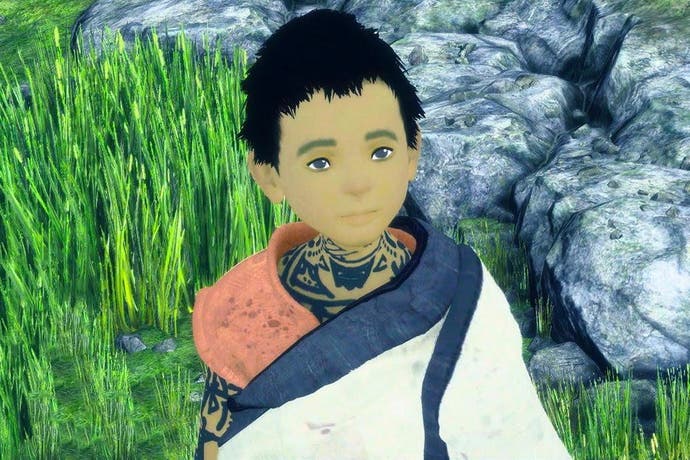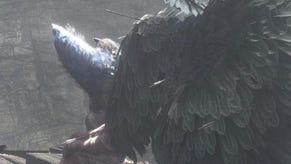Tech Analysis: The Last Guardian
Digital Foundry tracks the game's progress from initial target render to final code.
The Last Guardian is out at last. After the release of Ico in 2001 and Shadow of the Colossus four years later, it's fair to say Team Ico's third game has had the most troubled development of them all. When it began as a PS3 title in 2007, nobody could have anticipated a nine year wait to see the title on store shelves. But on its own terms the result is breathtaking; despite the age of its concept - and many of its assets - The Last Guardian's backdrops still wow due to on-point art direction from director Fumito Ueda. The story behind its technology however, from a leaked target render in 2009, to its eventual release in 2016, plays a big part in explaining how the final game turned out.
While it may have been announced in 2007, our first actual sighting of The Last Guardian came in 2008, through a public job advert. One image was released next to it: the mysterious motif of a chain leading into the ground. Actual video of the title surfaced in mid-2009. A trailer leaked by playstationlifestyle.net, revealed a target render used by the developer, likely from a period earlier in development. It was an internal demo with a working title of Project Trico - a blueprint, much like Killzone 2's infamous first reveal, that Team Ico would strive to recreate using actual PS3 hardware. It showed the basic visual concept behind an eventual PS3 title, an almost CG-like presentation at points, though with some very obvious limitations.
Character shadows were missing and aliasing was prevalent, and while much of its content would appear in later media, some environments would be completely cut from later trailers. Even so, you could see the same rendering techniques used in Shadow of the Colossus translating directly to this new engine. Particularly the ruined, Aztec-style architecture, the faux HDR lighting, motion blur, depth of field, and physics-based elements on chains, and even body ragdolls. It was all there, and very much in standing with the team's previous hit. This render serves as a fascinating mid-point between Team Ico's work on Shadow of the Colossus and a true PS3 engine we'd get to see just a few months later.
At Sony's E3 2009 conference the game got its first official trailer, now renamed as The Last Guardian. Surprisingly this was almost shot-for-shot identical to that target render, meaning you could compare the two directly to spot big changes. For example, rendering of grass shifted away from a fuller, geometric design, to less taxing alpha transparencies for each tuft. Lighting was improved overall, though the motion blur was downgraded to use fewer samples.
The biggest change by far was in environment and character designs. The Aztec style architecture of the target render was no more, and the E3 trailer moved to more ornate, mossy temples with a grey colour pallet. In the end, this aesthetic is closer to what we'd in the final product. The boy's model was also replaced, going from a basic design clearly meant as a placeholder, to a more detailed model with a visibly higher polygon count. As for Trico, feather rendering took a step up too, suffering from less pop-in across his body during a final panning shot. This early trailer set in stone the visual style that would stick for years to come.
In retrospect, director Fumito Ueda confirmed that this 2009 showing was actually running on genuine PS3 hardware. However, due to performance being so poor at the time, he states the team opted for a non-realtime solution. Simply put, the build would render at lower the frame-rate, before increasing playback speed to disguise PS3's poor performance. In motion it looked buttery smooth - a clear 30fps in the feed - and did a great job of hiding the game's troubled development. It's also fair to assume this was targeting 720p on PS3 at best, the most common target resolution of the generation, and a far cry from the peak 1890p we'd eventually get on PS4 Pro.
To the outside world, release seemed imminent at this point. There was real optimism around 2010 in particular that The Last Guardian would be released after so much waiting - and a holiday 2011 release date was revealed. In truth, the TGS 2010 trailer would in fact be among the last footage we'd see of The Last Guardian for six years. It was around this time that development struggles were aired out in public, with word that other studios - such as Sony Santa Monica - were pitching in with optimisation work on PS3. Trailers stopped being released, and only rarely was there an indication from Sony that the project was still alive. In early 2012, a long generation was coming to a close. The PS3's time was coming to an end, and Sony's new console, the PS4, was shaping up for reveal the following year. According to Sony's Shuhei Yoshida, it was at this point the team moved its engine to the new hardware.
With the game so tightly customised to the PS3's Cell processor, this was reportedly not an easy process - taking a year to get it running with a radically different AMD architecture. To make matters even trickier, Team Ico had also disbanded, with key team members such as Fumito Ueda going on to form a new studio, Gen Design. The original talent behind The Last Guardian worked by contract on the project, but it was very much in the hands of Sony Interactive Entertainment Japan, and help from its global studios, to finish the work it had started.
At last, the game was finally reintroduced with a lengthy slice of gameplay at Sony's E3 2015 conference. Officially confirmed as a PS4 title, it ran at a crisp native 1080p, showing off a collapsing bridge sequence that laid bare the game's mechanics. This was a big statement of intent from Sony. The frame-rate is, in effect, more representative of what we'd eventually get on PS4 Pro at 1080p - a fairly solid 30fps despite lots of physics-based action, where the standard PS4 would struggle.
Comparing the visuals between this 2015 demo and the final release in 2016, it's a very similar beast, though with a few notable changes. The colour tone is lighter on the older build, while geometry and environmental detail receive very minor shifts between builds. Overall, the 2015 re-reveal is still a fair reflection of the final game. In fact, what we have now is perhaps better in pure technical terms: the last flourishes on the title appear to include a more refined ambient occlusion solution, for example. Shading between objects and character was certainly factored in on the E3 2015 trailer, but it's more prominent in the final build.
The final game isn't without its blemishes, but captivates largely on the merits of its visual style. Without a doubt, it's the true successor to Ico and Shadow of the Colossus, a release made all the sweeter knowing it may never have happened. However, it is hard to shake the sense that the core technology has a through-line, going all the way back to that E3 2009 showing. The visual improvements are clear, but for better or worse, playing The Last Guardian can be like opening a time capsule from 2009, an age where 3D camera and character controls were still being refined by the team.
The good news is that Team Ico excelled - even back then - in several areas that help The Last Guardian game hold up on PS4 today. Animations are a genuine high point. On Trico, his ears flap individually, he reels back when he's nervous, while a playful mood has him rolling belly-up in water - all details that bring the creature to life. Also building on the work started with Shadow of the Colossus is rendering of fur. Trico's covered in a dense plume of feathers, bringing several new dynamics into the fold. One especially neat touch is the way small pockets of feathers billow in isolation, fluttering individually as if caught in the wind - much like hair on a cat or dog.
Individual parts of Trico can get soaked in water too, adding a reflective shader to only that part of his body. In this way, the creature is built around several parts, all adhering to their own logic. The tail can be dragged around manually for example - a tenet of its puzzle sections - while the front of his body rig is designed to rotate independently of the rear. The developer's in-house physics factor in heavily still, and body ragdoll and cloth simulation are in full force as the boy scales around this creature's frame. In many ways what we're handed is an enhanced take on the dynamics used in Shadow of the Colossus.
Parts of the final game are stuck in time though. Geometry and textures are good examples. Again, they're often simple but effective, with basic polygonal designs for each dungeon you come up against. It's a technical limit of the PS3 era that's factored into the game's visual style, though sharp angles on the architecture still work well for creating labyrinthine environments. There's also a convincing sense of scale to the world, where stepping outside reveals a maze of pillars, walls and towers leading far into the distance. Seeing some details up close - especially its low resolution textures - it's a game that has clear roots in the PS3 era, but at a distance it still holds up well, even at 1890p.
Many of these limits are at least hidden by the game's excellent lighting. Volumetric lighting and bloom give the game a distinctively saturated look, a trademark of the developer's previous titles. High dynamic range support on PS4 - which activates automatically if you have a compatible TV - also takes advantage of the inherently wide contrast between light and dark in most scenes. As a final image, colours are very much muted, but lighting is natural and easy on the eye. There are welcome embellishments on top of this too, like a baked subsurface scattering effect. The accuracy of the simulation here is such that the boy's ears turn a light pink when the sun's positioned behind him, but turning back, it returns to its normal colour.
Screen space reflections are used across bodies of water. The ordering of elements, like grass and geometry can sometimes appear muddled, but it does factor in all movements from Trico, the boy, and rubble nearby. Unfortunately, not all visual elements hold up so well in this area: yes, you do have ambient occlusion around grass, but most foliage in the game suffers from an obvious stippling effect. It's a dither that causes grassy areas to flicker as you pan the camera - something the game's anti-aliasing struggles to address.
On the other hand, The Last Guardian has plenty of post-process effects that bolster the end result. Motion blur is pristine and has a filmic quality, with none of the banding artefacts we saw in that 2009 demo. A frame-blending technique is also used, similar to Shadow of the Colossus and Ico, blurring the image slightly - though nowhere near as aggressively. This appears obviously on the PS4 Pro version in the 4K mode, giving it a hazier look than we might expect from a native 1890p image. Camera changes during cut-scenes show a kind of cross-fade as a result, but curiously, we don't get this on the standard PS4, or even PS4 Pro in the 1080p mode.
Overall, the technical showing from The Last Guardian is mixed, but the title still shines brightly thanks to the timeless quality of its visual direction. Clearly, both textures and world design show the project's age, but the rendering techniques over the top help it hold up in the current day. After all the delays, the many different iterations and builds shown at trade-events, along with the move to new hardware, some might say that it's surprising that we've ended up with a finished product at all. The path to release has been long, but for fans of Ico and Shadow of the Colossus, it's certainly been worth the wait.













